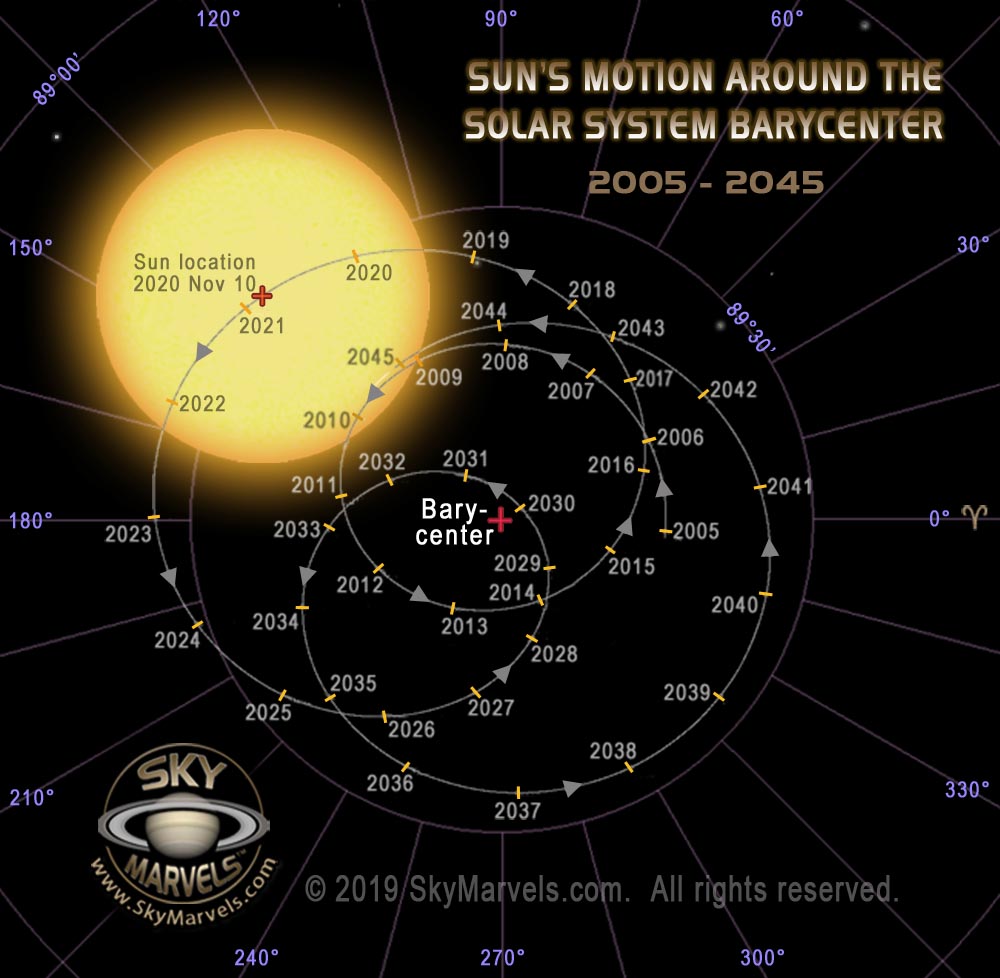


THE SOLAR SYSTEM BARYCENTER

Though we often say that the planets orbit the Sun, it is more accurate to say that the Sun, the planets and every other body in our solar neighborhood actually orbit—either directly or secondarily—the center of mass of the entire Solar System, a point we call the "Solar System barycenter". This is the "balance point" of all matter in the Solar System, a point which the Sun slowly "orbits" in a complex, irregular spiral! The map above—which looks down on the very center of the Solar System—gives a good sense of the ongoing orbital gyrations of our parent star. The animation near the bottom of this page expands on the factors that give rise to this phenomenon.
Taking a look at the Current Orbital Locations of the Planets is also quite revealing. During the early years of the 2020-2029 decade, the Gas Giants—whose substantial masses most greatly affect the Sun's motion around the barycenter—are all seen on the "right half" of the map of the full Solar System, i.e. more or less toward the March Equinox ( ) in the constellation Pisces. To "balance" their great collective mass in the same time period, the Sun must move in the "left half" of the barycenter map above! And this is clearly what we see!
) in the constellation Pisces. To "balance" their great collective mass in the same time period, the Sun must move in the "left half" of the barycenter map above! And this is clearly what we see!
The image directly below illustrates two extreme examples of the conditions that give rise to the Sun's motion around the barycenter.


Of course it turns out that these "balance points" are quite common in the universe, even in our solar system itself. In fact, any "system" of two or more celestial objects has a barycenter! The Pluto-Charon barycenter
and the Earth-Moon barycenter are probably two of the best-known examples. Unfortunately, the discussion of the Solar System barycenter—and, for the most part, barycenters in general—is often quite limited or entirely neglected, even in some of the better astronomical texts. And yet scientists are discovering that the Sun's mo- tion around the Solar System barycenter may have profound effects, effects unimagined just a few decades ago. For example, some scientists cite compelling evidence that the 11-year sunspot cycle may be directly related to the Sun's complex spiral motion around the barycenter!
The intriguing online tool Gravity Simulator gives you numerous ways to map the Solar System barycenter and examine the Sun's spiraling motion around it for different eras. And more maps and animations of the barycen- ter are available on the SkyMarvels Sun page.
Home Intro News Gallery Sky-Gifts Bonuses Tips
Learning Ctr Help Links Credits Legal Contact Us
© 2007-
by Gary M. Winter. All rights reserved.
Interested in political cartoons and humor?
Check out The HIPPLOMATS™.
SkyMarvels, Sky Marvels, SkyMarvels.com, Solar System Barycenter, celestia4all, celestiaforall, CELESTIA, astronomy, space, simulations, animations, downloadable astronomy posters, stars, planets, Inner Planets, Outer Planets, Inferior Planets, Superior Planets, moons, asteroids, comets, Oort Cloud, galaxy, galaxies, Milky Way, Andromeda, globular clusters, binaries, quasars, black holes, supermassive black holes, telescope, telescopes, planetarium, software, freestuff, satellites, add-ons, addons, scripts, eclipses, Solar Eclipses, Lunar Eclipses, Solar Eclipse Finder, Lunar Eclipse Finder, mutual eclipses, transits, occultations, Solar System, CELES-TOOLS, celeSTARrium, CELX, CELX programming, Freebies, multiple views, atronomical unit, light year, parsec, meteors, meteor showers, Perseids, Geminids, Leonids, barycenter, time, Time Zones, tides, alignments, conjunctions, oppositions, seasons, apogees, perigees, aphelion, perihelion, Earth, Luna, Mercury, Venus, Mars, Jupiter, Galilean Moons, Io, Europa, Ganymede, Callisto, Saturn, Titan, rings, Uranus, Neptune, Triton, E-MSpectrum, electromagnetic spectrum, astronaut, equinoxes, solstices, precession, rotation, spin, inclination, tilt, Ecliptic, orbits, ellipse, parabola, hyperbola
